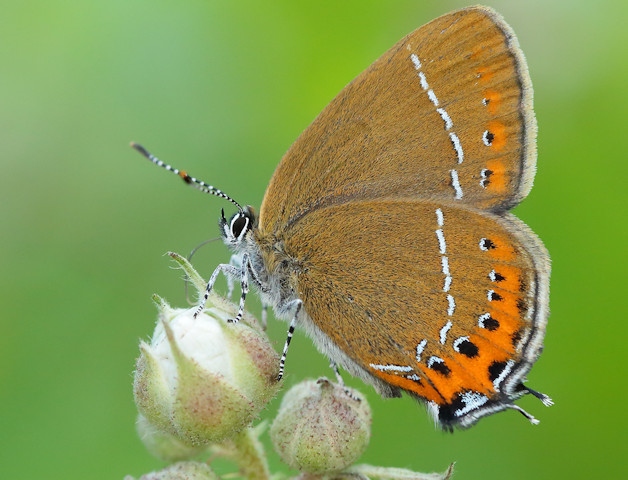Butterflies bounce back in heatwave summer
Date published: 08 April 2019

Black Hairstreak butterfly
UK butterflies bounced back in 2018 following a string of poor years, thanks in part to last year’s heatwave summer, a study has revealed.
More than two-thirds of UK butterfly species (39 of 57) were seen in higher numbers than in 2017, with two of the UK’s rarest, the Large Blue and Black Hairstreak, recording their best years since records began.
But despite the upturn, 2018 was still only an average year for the UK’s butterflies. Around two thirds of species (36 of 57) show an apparent decline since records began 43 years ago, with 21 of these showing significant long-term declines, the annual UK Butterfly Monitoring Scheme (UKBMS) led by Butterfly Conservation, the Centre for Ecology & Hydrology (CEH), British Trust for Ornithology (BTO) and Joint Nature Conservation Committee (JNCC) revealed.
Numbers of the threatened Large Blue rose by 58% from 2017 levels and the endangered Black Hairstreak was up by more than 900%.
Both species benefitted from warm and sunny weather when they were flying in the early summer, whilst the cold spell in February and March may have also helped by improving survival of caterpillars and chrysalises.
Brown Argus and Speckled Wood butterflies also thrived, recording their third best year on record.
Common white butterflies experienced a good year after a recent run of below-average seasons with Large White annual abundance up 118%, the Small White rising by 155% and the Green-veined White increasing by 63%, again due to warm and sunny weather from April to the end of July.
The threatened Duke of Burgundy was up 65%. This butterfly has been the subject of intensive conservation efforts in recent years from Butterfly Conservation and partners, with some of the biggest annual increases seen at conservation sites. The butterfly’s population has stabilised over the last 10 years in the face of a significant long-term decline.
The hot spring and summer weather was not ideal for all species. Some grassland butterflies struggled, not helped by drought conditions drying out caterpillar food plants. The Gatekeeper dropped by 20% from 2017 levels and the Small Skipper and Essex Skipper were down by 24% and 32% respectively.

It was also a surprisingly poor year for some garden favourites. The Small Tortoiseshell slumped by 38% compared to the previous year and the Peacock was down 25%, whilst the migratory Red Admiral crashed by 75% after a good year in 2017.
Professor Tom Brereton, Associate Director of Monitoring at Butterfly Conservation, said: “2018 brought some welcome relief for butterflies following five below average years in a row. But, there were not as many butterflies around as we might have expected given the fabulous weather over much of the butterfly season and overall 2018 ranked as barely better than average.
“This and the fact that two thirds of butterflies show negative trends over the long-term, highlights the scale of the challenge we face in restoring their fortunes and creating a healthier environment.
“It remains to be seen what the knock-on effects of the 2019 heatwave will be. We know that extreme events such as this, which are set to increase under climate change, are generally damaging to butterflies.”
Dr Marc Botham, Butterfly Ecologist at the Centre for Ecology & Hydrology, said: “The results show the positive impact that suitable weather conditions can have if there is suitable habitat in place for our butterflies to thrive.
“Thanks to ongoing habitat management, many of our threatened species can benefit from the good weather like that of summer 2018, but more still needs to be done to improve the condition of the wider countryside as a whole so other species can also take advantage. This can start in our own back gardens, by leaving areas unmown and planting native wildflower species, for example.”
The UKBMS has run since 1976 and involves thousands of volunteers collecting data through the summer. Last year a record 2,873 sites were monitored across the UK.
The scheme is organised and funded by Butterfly Conservation, the Centre for Ecology & Hydrology, the British Trust for Ornithology and the Joint Nature Conservation Committee.
Do you have a story for us?
Let us know by emailing news@rochdaleonline.co.uk
All contact will be treated in confidence.
Most Viewed News Stories
To contact the Rochdale Online news desk, email news@rochdaleonline.co.uk or visit our news submission page.
To get the latest news on your desktop or mobile, follow Rochdale Online on Twitter and Facebook.

